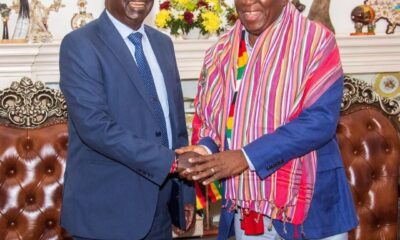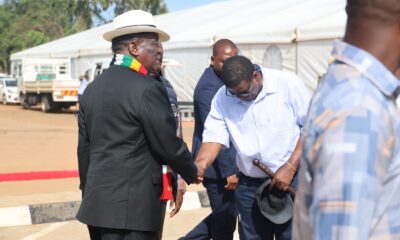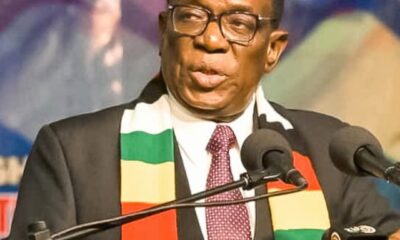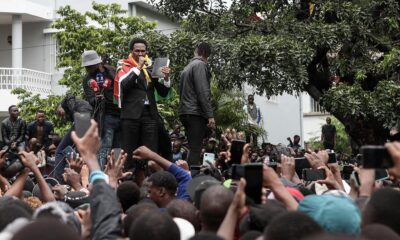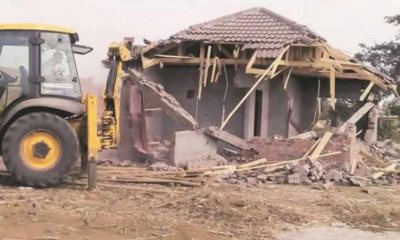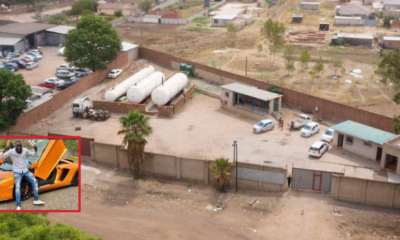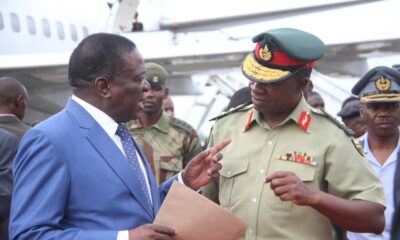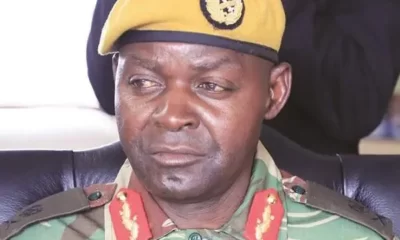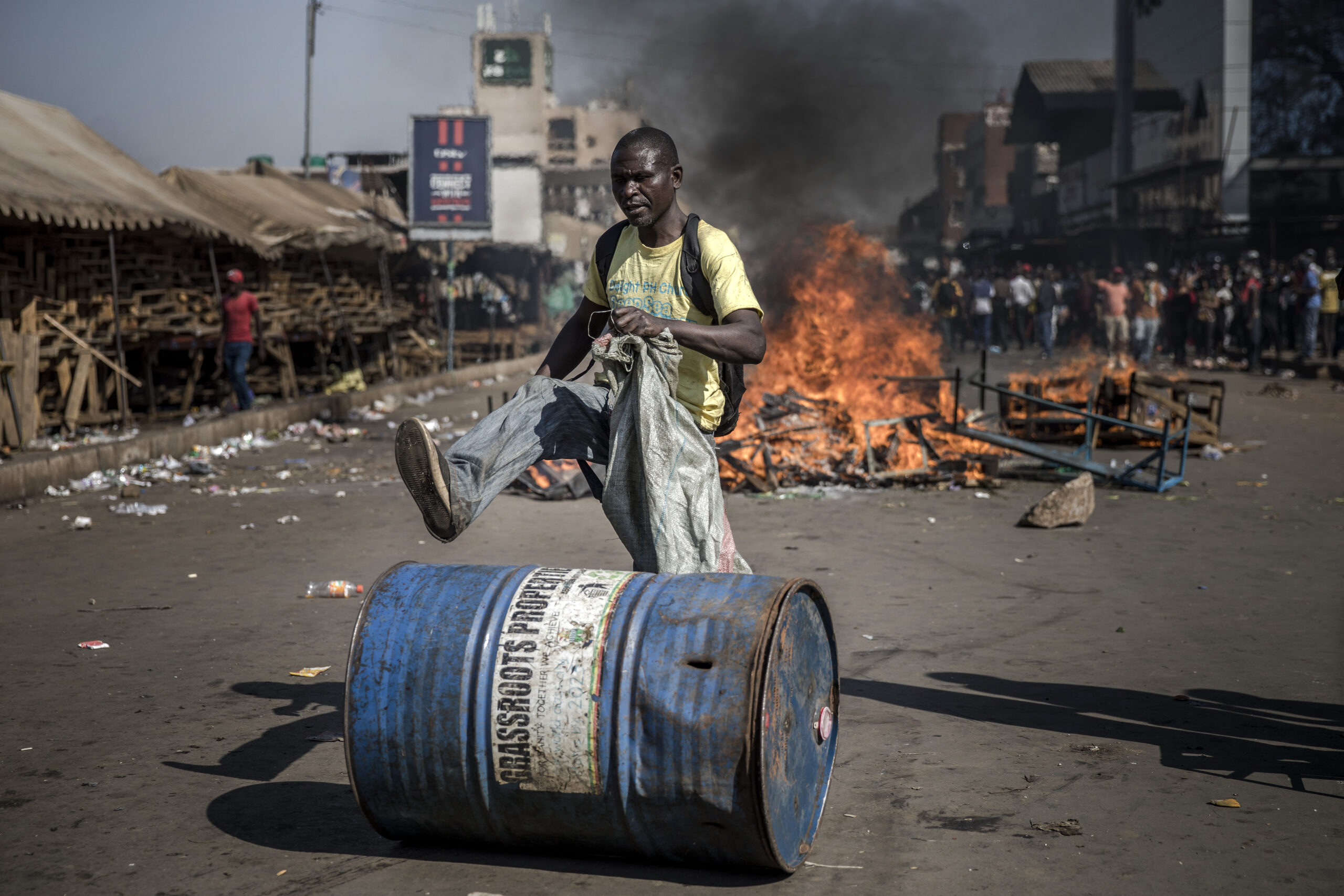
News
Dynamics of the Zimbabwe crisis in the 21st Century
Published
4 years agoon
By
NewsHawksThis opinion by Sabelo J. Ndlovu-Gatsheni was supposed to be published last week but unfortunately due to space constraints we regrettably couldn’t accommodate it.
Continued from 30 July issue
All the above efforts were meant to fulfil the aspirations and wishes of the people and were part and parcel of the nationalist legacy of populism. However, while all these commendable steps were being taken, an opposite development was taking place concurrently – in the wrong direction and away from the people.
It must be noted that the authoritarian legacies from the nationalist liberation struggle emphasised the concept of monolithic unity. The result was that even the celebrated policy of reconciliation announced by the government in 1980 was not part and parcel of acknowledgement of diversity, but was a move to co-opt the former warring parties into the dominant party structures.
The same is true with regard to the idea of a government of national unity.
These populist policies were meant to endear the opposition into joining forces with Zanu PF and at the end being swallowed up. This argument is vindicated by the case of PF Zapu, which joined forces with Zanu PF to form the first coalition government of Zimbabwe in 1980, but was later violently crushed because of its attempt to continue as an opposition movement. Indeed PF Zapu ended up being swallowed by ZANU-PF.
As noted by Richard Saunders in his book, Never the Same Again:
Zimbabwe’s Growth Towards Democracy, the top-down strategies and politics needed to win a liberation war strongly influenced the behaviour of the nationalist parties once they were in power. The nationalist leadership now in government soon displayed strong signs of intolerance, which raised questions about the nature of Zimbabwe’s emerging democracy (Saunders 2000:20). Intolerance and authoritarianism permeated the official populist ideology and the dominant political rhetoric. Immediately after 1980, the ruling elite began to subordinate imperatives of economic development and people’s freedom to the major goals of regime security and keeping Zanu PF in power forever.
A number of factors complicated Zimbabwe’s growth to democracy, and favoured growth towards regime security. In the first place, rural assertions of collective rights to land, tradition and local economy soon conflicted with the state-led, state-determined, state-formulated and confident interventions in the people’s lives.
Secondly, workers’ attempts to assert their rights and their demands for a solution to their long standing grievances dating back to the colonial period, soon conflicted with the hegemonic desire of the ruling party to subordinate trade unions and to speak on their behalf.
Thirdly, the women’s advocacy movements inevitably came to clash not only with the essential patriarchy of African nationalism but also with the new government’s desire to de-politicise and re-domesticate women (Ndlovu-Gatsheni 2003a:10-15; Ranger 1985; Kriger 1992; Raftopoulos & Phimister 1997; Raftopoulos 1992; Nhongo-Simbanegavi 2000).
As noted by Bhebe and Ranger, the Zimbabwean situation in 1980 was a complex and plural one, which required complex and multiple solutions. However, the ruling Zanu PF government attempted to use a hegemonic and monolithic solution underpinned by the sword of its violent agencies inherited from the past such as the party Youth League, Women’s League, ex-combatants, the Central Intelligence Organisation (CIO) and the army (Bhebe & Ranger 2003:18).
In the 1980s, an ambiguous and contradictory situation prevailed in Zimbabwe whereby the powerful aspirations of the ordinary citizens for rights, democracy and human security co-existed with the strong and resilient practices of authoritarianism and violence.
This meant that even the noble ideas of welfare socialism that undoubtedly promoted human dignity in the 1980s, were tainted with top-down authoritarianism. The situation was further complicated by the pre-occupation with regime security, which by its very nature allowed for official violence at the expense of human security.
It is vital to note that a number of factors indicated the government’s move away from the people to its pre-occupation with regime security.
The first move was the creation of so-called ‘politically correct’ military units, parallel to the national integration of Zipra, Zanla and Rhodesian forces into a unified Zimbabwe National Army (ZNA) (Mazarire & Rupiya 2000; Ndlovu-Gatsheni 2003c).
Secondly, there was the move to destroy PF Zapu as an opposition party through violent means.
Thirdly, there was enthusiasm in the use of the military in the maintenance of internal order.
Fourthly, there was the official sanction of violence against the citizens, particularly the workers, students and members of the opposition movements.
One of the disturbing issues about Zimbabwe in the 1980s was the failure of the society to de-militarise itself more rapidly in line with the new political realities. Such a de-militarisation was itself an indispensable pre-requisite for the entrenchment of a new culture of peace, human rights, democracy and human security.
However, instead of adopting a broad-based de-militarisation process, the new ‘politically correct’ military units were formed such as the North Korean trained Presidential Guard, the Artillery Regiment, the People’s Militia and the notorious Fifth Brigade. These units were highly politicised and partisan, and they were formed in the midst of and parallel to the tenuous demobilisation of some ex-Zanla, ex-Zipra and ex-Rhodesian forces (Mazarire & Rupiya 2000:72-73).
Thus, the overarching framework of de-militarisation was abandoned midway as the Zanu PF government felt threatened. Zimbabwe had to deploy forces on two fronts in the early 1980s, barely two years into independence.
This was on the external front in Mozambique along the Beira, Limpopo and Nyamapanda Corridors and inside the country in Matebeleland and the Midlands (The Catholic Commission for Justice and Peace and the Legal Resources Foundation 1997).
In 1981, Robert Mugabe justified re-militarisation of Zimbabwe by saying “a large army is necessary to answer the threat that South Africa poses to our democracy” (Martin & Johnson 1986:51-76).
The de-militarisation process was also marked by the failure to achieve a non-violent and smooth integration of ex-Zipra, ex-Zanla and ex-Rhodesian combatants into the new ZNA. This failure was demonstrated by savage fighting between the ex-Zipra and ex-Zanla forces at Entumbane, Connemara and other Assembly Points (APs) around the country, as well as the defection of some ex-Zipra combatants from the ZNA and the fleeing of others into the countryside to become what became known as “dissidents” (The Catholic Commission for Justice and Peace and The Legal Resources Foundation 1997).
What is even more revealing about the ruling Zanu PF’s conception of peace and security, came from the government response to the so-called ‘dissident problem’ in Matebeleland and the Midlands. As noted by Bhebe and Ranger (2003:21), the violent response was not conditioned by objective security dangers but more by the nature of Zimbabwean nationalism.
Government forces, particularly the newly formed “politically correct” units sympathetic to Zanu PF as a party, combed the Matebeleland and Midlands villages, looking for the ex-Zipra forces. In the process gross violations and abuse of civilians’ rights were committed by the military.
The atrocities committed in Matebeleland and the Midlands are well documented in the Catholic Commission for Justice and Peace in Zimbabwe and the Legal Resources Foundation Report, Breaking the Silence: Building True Peace: A Report on the Disturbances in Matebeleland and the Midlands, 1980 to 1988 (The Catholic Commission for Justice and Peace and The Legal Resources Foundation 1997) and in a courageous academic book written by Jocelyn Alexander, Joan McGregor and Terence Ranger, Violence and Memory: One Hundred Years in the ‘Dark Forests’ of Matebeleland (Alexander, McGregor & Ranger 2000).
The violence that engulfed Matebeleland and the Midlands in the 1980s demonstrated more than any other episode in the history of independent Zimbabwe, the Zanu PF regime’s preparedness to use violence against defenceless citizens.
The ruling party, in a bid to violently crush once and for all PF Zapu as an opposition movement, eagerly seized the security problem in Matebeleland and the Midlands. Enthusiastic, politically motivated and partisan forces such as the CIO, Fifth Brigade, Zanu PF Youth Brigade, Police Internal Security Intelligence (Pisi), Zimbabwe People’s Militia (ZMP) and others less enthusiastic forces such as the ZNA, the Police Support Unit (PSU) and the Zimbabwe Republic Police (ZRP), lumped together PF Zapu as an opposition party, PF Zapu leadership, PF Zapu supporters, the de-mobilised ex-Zipra combatants and all Ndebele speaking people as ‘dissidents’ and as a security threat (Ndlovu-Gatsheni 2003c:16-23; Nkomo 1984; Werbner 1991; The Catholic Commission for Justice and Peace and The Legal Resources Foundation 1997).
As a result of the violent handling of the security situation in Matebeleland and the Midlands, the remaining hopes for human security and the expected spaces of peace, democracy and human rights in the two regions and the rest of the country, were rapidly replaced by the culture of fear, suspicion and insecurity (Ndlovu-Gatsheni 2003c:16-24).
The insecurity grew as a result of the realisation by the people that the atrocities were not an accident but officially blessed by the ruling elite of Zimbabwe. For instance, in April 1983 Robert Mugabe as the Prime Minister stated that:
Where men and women provide food for dissidents, when we get there we eradicate them. We don’t differentiate when we fight, because we can’t tell who is a dissident and who is not… (Lawyers Committee for Human Rights 1986:38).
In the same month 1983, Emmerson Mnangagwa, who by then was the Minister of State Security, told a gathering of Ndebele speaking people in Matebeleland North, that the army had come to Matebeleland like fire and that in the process of cleansing the area of the dissident menace, had also wiped out their supporters.
He went on to state in a parody of scriptures that: Blessed are they, who will follow the path of the government laws, for their days on earth shall be increased. But woe unto those who will choose the path of collaboration with dissidents for we will certainly shorten their stay on earth (The Chronicle 1983).
Another culprit was Enos Nkala, the Minister of Home Affairs. He did not mince his words when it came to the intentions of the violent campaign in Matebeleland and the Midlands. He once stated that:
We want to wipe out the Zapu leadership. You’ve only seen the warning lights. We haven’t yet reached full blast…the murderous organisation and its murderous leadership must be hit so hard that it doesn’t feel obliged to do the things it has been doing (Lawyers Committee for Human Rights 1986:52).
All these statements and speeches were said in the midst of the violence in Matebeleland and the Midlands, and had the effect of making the security forces commit more and more atrocities up until the time of the Unity Accord in December 1987.
The celebrated Unity Accord as a conflict resolution measure succeeded only in meeting the minimalist conditions for peace, human security and human rights. On the positive side, one can cite the fact that the violence that had engulfed Matebeleland and the Midlands for almost a decade came to an end.
However, modern studies on conflict resolution and peace building such as F. Deng and I.W. Zartman’s Conflict Resolution in Africa and P. Mathoma, G. Mills and J. Stremlau’s Putting People First: African Priorities for the UN Millennium Assembly, have clearly shown that the absence of overt violence or open conflict does not mean that there is peace and security in a society (Deng & Zartman 1991; Mathoma, Mills & Stremlau 2000).
One of the tragedies of the Unity Accord is that it was not a product of a broad-based democratic consensus that included the people’s voices. It was part and parcel of the authoritarian and top-down strategies of Zanu PF meant to strengthen regime security rather than to entrench the desperately needed culture of democracy and peace.
The agreement was confined to the top leadership of PF Zapu and Zanu PF. What was at stake was not the security of the people but power sharing among the political elites.
As such the Accord lacked a comprehensive post-conflict peace building arrangement, which is always necessary for the enhancement of human security. Worse still, the swallowing of PF Zapu by ZAlanu PF tended to confirm the success of the authoritarian legacy of nationalism predicated on monolithic unity rather than diversity and pluralism (Chiwewe 1989:242-286; Ndlovu-Gatsheni 2003c:19-28).
The Unity Accord was at best a pact between the petit-bourgeois nationalist elite in PF Zapu and Zanu PF, who by the fact of their common class position realised that they shared a common ideology.
As such, the post unity period saw the “new united” Zanu PF openly pushing for a legislated one-party state in Zimbabwe. Saunders saw this as one of the clearest examples of the government’s move away from the people.
He argued that the party leadership worked determinedly towards the establishment of a one-party state using the following means: the tightening of control over debate and political expression within the ruling party; the promulgation of the party’s views and perspectives (to the exclusion of others) in the wider space of civil society; and the “colonisation” by the party of the state, the bureaucracy and a range of public institutions.
Most importantly, it involved the marginalisation if not eradication of the opposition parties, which were seen as the chief obstacle to one-party rule (Saunders 2000:20-21). The details on the debate on the one-party state in Zimbabwe are well captured in Ibbo Mandaza and Lloyd Sachikonye’s book, The One Party State and Democracy: The Zimbabwe Debate (Mandaza & Sachikonye 1991).
The ruling party moved away from identification with the basic aspirations of the masses, remaining in agreement with popular hopes only at the level of rhetoric. The government leadership pursued its own enrichment at the expense of the people. Corruption and primitive wealth accumulation by the political leadership led to the introduction of a Zanu PF leadership code in 1984, as a means of curbing avaricious behaviour on the part of senior party and government officials (Zanu PF Leadership Code 1984).
The state, the government and the ruling party became alienated from the people. The people realised that the political elite was beginning to betray them. The ruling party quickly realised the danger of being rejected by the people, hence it intensified the agenda of a one-party state that was going to close the door for regular elections as well as party choice. Despite the fact that the agenda of a legislated one-party state was officially shelved in 1990, the ruling party continued to devise more strategies of keeping power and destroying opposition.
One of Zanu PF’s most eloquent and articulate ideologists, Dr Eddison Zvobgo, superbly summed up his party’s obsession and pre-occupation with regime security in the following manner:
A party’s eyes are focused on one thing if it is a political party: conquest of power, and retention of power. Conquering power and keeping it – that is the primary function of Zanu PF (Saunders 2000:38).
The one-party state political system was meant to be the major method of keeping power in the 1990s. The liberation war and the violent military campaign in Matebeleland and the Midlands were used to conquer power by Zanu PF in the 1980s. In its quest to remain in power in the 1990s, Zanu PF used the following broad methods:
constant amendments to the constitution, manipulation of state institutions, coercion, intimidation and outright violence.
In pursuit of regime security, Robert Mugabe was elevated from a Prime Minister to an Executive President with very wide, discretionary and arbitrary powers. For instance, the president was given unlimited powers to interfere with the electoral process and even to manipulate it to the advantage of the ruling party (Constitution of Zimbabwe; Moyo 1992:43-50, Makumbe & Compagnon 2000:15-35).
The idea was to make sure that all restraints on absolute and supreme power were removed, and the intention was to create an ‘imperial presidency’ in Zimbabwe.
Besides the use of strategic electoral reforms, Zanu PF has mobilised other aspects of the state machinery to guarantee regime security. John Makumbe and Daniel Compagnon’s book, Behind the Smokescreen: The Politics of Zimbabwe’s 1995 General Elections and Jonathan Moyo’s Voting for Democracy, provide detailed evidence of the openly partisan use of public facilities by Zanu PF, including a monopolistic access and use of publicly-owned media, such as the Zimbabwe Broadcasting Corporation (ZBC) and Zimpapers, as party mouthpieces during and after elections (Moyo 1992; Makumbe & Compagnon 2000).
Muzzling of opposition is another strategy used by Zanu PF to remain in power. Opposition political movements in Zimbabwe have not been tolerated by the ruling Zanu PF party ever since 1980. The intolerance of opposition was embedded in the nationalist struggle itself, where disagreement could lead to death.
Beginning with PF Zapu in the 1980s, opposition movements have been treated as political enemies rather than political opponents. The strategy used to destroy PF Zapu combined outright violence and attempts to ‘rubbish’ its nationalist credentials.
The leader of PF Zapu, Joshua Nkomo was subjected to character assassination. He was portrayed as a coward who reluctantly embraced the armed struggle and who always avoided detention by going overseas. Nkomo’s continued search for peace through negotiations with Ian Smith until 1976 was portrayed as an act of selling-out. Nkomo was said to have committed a few military forces to the front, keeping the bulk of well-trained forces in Zambia with the intention of staging a coup d’état if Zanu PF won elections.
For instance, Robert Mugabe in 1983 publicly called for violent action against Joshua Nkomo’s person. He told the supporters of Zanu PF that:
Zapu and its leader, Dr Joshua Nkomo, are like a cobra in a house. The only way to deal effectively with a snake is to strike and destroy its head (Nkomo 1984:2).
The harassment of PF Zapu leadership and the killing of its supporters, which began in 1983 and continued up to 1987, forced PF Zapu to enter into a unity agreement with the ruling party and into a process of disbanding itself as a political party.
The year 1989 saw the formation of the Zimbabwe Unity Movement (ZUM) by Edgar Tekere. This party vehemently opposed the one-party state agenda of the ruling party in its campaigns throughout the country. Like Zapu, ZUM was harassed and its supporters attacked by the supporters of the ruling party.
The clearest case of intolerance of ZUM by the ruling party was the shooting of Patrick Kombayi in broad daylight by a state agent (Saunders 2000:41). The other opposition parties that existed included Zanu (Ndonga), the United Parties (UP), the Zimbabwe Union of Democrats (ZUD) as well as the MDC formed in 1999.
The other clear strategy used by Zanu PF to frighten the opposition is to trump up treason charges against opposition leaders. In the 1980s, Dumiso Dabengwa and Lookout Masuku of PF Zapu languished in detention on unproven charges of wanting to dethrone the government of Zanu PF. In the 1990s, Reverend Ndabaningi Sithole of Zanu (Ndonga) was also summoned before the courts on charges of attempting to kill president Robert Mugabe and for forming a rebel movement called Chimwenje.
In the run up to the March 2002 presidential elections, the MDC leaders, Morgan Tsvangirai, Professor Welshman Ncube and Renson Gasela were hurled before the courts on treason charges of organising with a Canadian consultant firm to assassinate president Robert Mugabe. In February 2003, the treason trial began in the Supreme Court in Harare based on a very unclear videocassette and very unreliable state witness, Ari Ben-Menashe. All this was and is being done to enhance regime security of Zanu PF in Zimbabwe.
The democracy and human rights crisis of the 1990s
The Zanu PF regime has not taken the people’s quest for democracy and human rights kindly. For instance, following the findings of the Sandura Commission and student demonstrations against corruption in high places as well as the rejuvenation of a critical voice from the civil society, Robert Mugabe admitted that:
We now must admit that we are reaping the bitter fruits of our unwholesome and negative behaviour. Our image as leaders of the party and government has never been so tarnished. Our people are crying for our blood and they certainly are entitled to do so after watching our actions and conduct over the nine years of our Government (Saunders 2000:37).
Indeed the people had been watching the actions of the ruling party and the government busy trying to ‘privatise’ politics as a preserve of the petit-bourgeois nationalists that led the liberation struggle from Zambia and Mozambique in the 1970s. The people also watched the avaricious behaviour of the party leaders in accumulating wealth at the expense of the peasants, workers, youth, students and women.
As a result of these observations coupled with international and regional developments of the 1990s, including the end of the Cold War, the fall of the Soviet Union, the crumbling of the Communist regimes of Eastern Europe, the retreat of apartheid in South Africa and the collapse of dictatorial and one-party state regimes of Kenneth Kaunda in Zambia and Kamuzu Banda in Malawi, Zimbabwe entered its own ambiguous and contradictory period of glasnost (Saunders 2000:35).
These developments did not only expose the one-party state system model of government as prone to corruption, dictatorship and unworkable, but also inspired a renewed debate and activism on the part of Zimbabwean civil society formed around the pertinent issue of good governance, democracy, human rights and human security.
The Zanu PF government was forced to abandon its selfish idea of establishing a one–party state in Zimbabwe. Under pressure from the civil society, particularly students, workers and intellectuals, Zanu PF government was also forced to repeal the colonially conceived and constructed State of Emergency (Ncube 2001).
During the same period of hope and anxiety, the government adopted the neo-liberal Economic Structural Adjustment Programme (Esap), without consulting the people. This arbitrary decision reminiscent of the authoritarianism of the 1980s provoked widespread criticism, mainly by the workers and the students (Mlambo 1997).
The adoption of the Western conceived ESAP and misinforming people that it was home grown was a direct assault on the economic and social security of the people. Government subsidies on health, food, education and other basic social protection schemes were removed. Prices of goods skyrocketed in the midst of retrenchments.
The workers through the Zimbabwe Congress of Trade Unions (ZCTU) embarked on strikes and stay-aways, which were met by violent response from the government.
What is even more important to note is that the adoption of Esap did not only demonstrate the abandonment of the people by the government, but also the successful transformation of the Zimbabwean petit-bourgeois nationalists over time into a state-based bourgeoisie with capitalist interests. Hence the ease with which it readily embraced neo-liberal structural realities against the wishes of the people.
This, however, happened within an ambiguous and contradictory framework characterised by a fragile process of accumulation that was being curtailed by the same Esap. With the adoption of Esap the Zanu PF leadership became less and less concerned about the welfare needs of the peasants and workers and abandoned the goal of equity (Mlambo 1997).
Thus, by the 1990s, the Zimbabwean former nationalist elites had not only arrived at the accommodation of each other through the Unity Accord but also accommodated itself with global capital, which made the adoption of Esap attractive and feasible (Bhebe & Ranger 2003:23-4; Bond & Manyanya 2002; Nabudere 2000).
While the conditionality of the Western Financial Institutions (FIs) like the World Bank (WB) and International Monetary Fund (IMF) dictated the need to adopt triumphant liberal democratic political reforms as well as reduced cabinet, this was ignored by Zanu PF as a threat to regime security.
Instead of opening up the political space the Zanu PF government tightened its grip on power through intolerance of any opposition. This led to what Bhebe and Ranger (2003:19) preferred to term “the rights and democracy crisis of the late 1990s”.
The crisis was precipitated by the fact that the welfare socialism of the 1980s was now scrapped by Esap and in the political arena there was no credible opposition to chart an alternative political dispensation. People demonstrated their hatred of Zanu PF politics by just not participating in elections in large numbers.
Political analysts came to talk about apathy. This was not until the civil society organisations, particularly the ZCTU and some new human rights groups like ZimRights, rose to the occasion to fill the political vacuum (Moyo, Makumbe & Raftopoulos 2000).
The civil society organisations such as the Zimbabwe National Liberation War Veterans’ Association (ZNLWVA) and others were committed to address their members’ needs and interests in the face of the deepening economic crisis and the devastating HIV and Aids pandemic. Others like the Catholic Commission for Justice and Peace, the Zimbabwe Council of Churches and the Legal Resources Foundation concentrated on the protection of people’s rights in the face of an arrogant, corrupt and power-hungry political elite manning the state. There were also women movements such as Women Action Group (WAG) and Msasa Project, which concentrated on the protection of women’s rights (Moyo, Makumbe & Raftopoulos 2000).
The government response to the pressure from the civil society organisations involved the use of the ‘stick and carrot’. Attempts were made to castrate the ZCTU and the students through introduction of the Labour Relations Amendment Act of 1992 and the University Amendment Act of 1990.
These two instruments were meant to limit the autonomy and assertiveness of the workers and the students in the political landscape of the 1990s. In 1995 the government introduced a further draconian piece of legislation in its bid to contain the pressure from various civil society organisations in the form of the Private Voluntary Organisations Act (PVO). This Act replaced the liberal Welfare Organisations Act of 1967 (Saunders 2000:74-79).
However, these harsh measures were not able to extinguish the pressure of civics. For instance, in 1997 the ZNLWVA openly confronted the government, demanding to be given compensation and gratuities for their participation in the liberation struggle.
They accused the government of being negligent on the plight of the war veterans. Their struggle successfully forced the government to award each war veteran a ZW$50 000 lump sum, a ZW$2 000 monthly pension and various other social benefits. This preferential treatment extended to the war veterans bought them to the side of Zanu PF, and they were and are being used by the party to intimidate, harass, threaten, and even torture civilians on behalf of Zanu PF.
The current struggle for democracy and human rights in Zimbabwe is still championed by the civil society, and the current credible opposition in the country was born out of the civics, more specifically the ZCTU and National Constitutional Assembly (NCA). The role of the civil society, particularly the labour movement in the struggle for democratisation in Zimbabwe, is well treated in Brian Raftopoulos and Lloyd Sachikonye’s brilliant and well edited book, Striking Back: The Labour Movement and the Post-Colonial State in Zimbabwe, 1980-2000 (Raftopoulos & Sachikonye 2001).
The MDC represents the most formidable challenges to the ruling party, though it has faced the same treatment as PF Zapu including the character assassination of its leader Morgan Tsvangirai. The party has been described as foreign sponsored and reduced to a front of the imperialist forces bent on the re-colonisation of Zimbabwe. The supporters of the MDC have faced threats to their lives, others have been killed and yet others detained (Zimbabwe Human Rights NGO Forum August 2001).
To constrain the operations of the MDC, the ruling party has enacted new draconian pieces of legislation such as the Public Order and Security Act (Posa). This piece of legislation has been used to harass MDC members and to deny them permits to hold rallies and to campaign freely. Despite the formidable factors working against it in the Zimbabwean political landscape, MDC has forged ahead, gaining 57 seats in the parliamentary elections and winning substantial votes in the presidential elections, nearly defeating the ruling party. At the moment the MDC is challenging the results of the presidential elections in the high court of Zimbabwe.
The Zimbabwe crisis and blocked democracy
The nationalist project represented by Zanu PF in Zimbabwe has failed to provide the broad masses of the people with human security and social peace. This failure is well treated in Patrick Bond and Masimba Manyanya’s most recent classic book, Zimbabwe’s Plunge: Exhausted Nationalism, Neoliberalism, and the Search for Social Justice, where they wrote that it is clear that two decades after independence, fatigue associated with the ruling Zanu PF’s malgovernance and economic mismanagement has reached a breaking point (Bond & Manyanya 2002).
The fact that Zimbabwe has reached ‘a breaking point’ is also implied in Amanda Hammar and Brian Raftopoulos’s recent book, Unfinished Business: Rethinking Land, State and Citizenship in Zimbabwe, where the two authors noted that the dramatic changes in Zimbabwe’s economic, political and social landscape since early 2000, have come to be known as the “Zimbabwe Crisis” (Hammar & Raftopoulos 2002). Moreover, this crisis takes place against a background of deeply entrenched structural impediments as well, which hinder the development of democracy in Zimbabwe.
The Zimbabwe crisis is basically that of legitimacy, governance, economic decadency as well as a humanitarian crisis.
It is worsened by the fact that the democratic embers are now trapped by the bankrupt and violent nationalist backlash. This is demonstrated by the widening polarisation and tension between the ruling Zanu PF and the civil society.
People are crying for protection from hunger, disease and poverty. Indeed Zimbabweans are facing a serious drought coupled with the existing ravaging HIV and Aids pandemic. Zanu PF’s legitimacy is under serious scrutiny and critique. Nationalism has lost its emancipatory appeal to the people. The threat of state violence has failed to silence the masses’ critique of existing bankruptcy of the existing government. Basic commodities such as mealie-meal, sugar, salt, petrol, bread and cooking oil are nowhere to be found in Zimbabwe.
The politics of the period from 1996-2002 witnessed a concerted effort to provide a ‘post-nationalist’ framework of debate. This post-nationalist position was clearly articulated in March 2000 by the MDC leader, Morgan Tsvangirai when he stated that:
In many ways we are moving away from the nationalist paradigm to politics grounded in civil society and social movements. MDC politics are not nationalist inspired, because they focus more on empowerment and participation of the people. Zanu’s thinking has always been top-down, centralised, always trapped in a time warp. Nationalism was an end in itself instead of a means to an end. One of Zanu’s constant claims is that everyone in Zimbabwe owes the nationalist movement our freedom. It’s therefore also become a nationalism based on patronage and cronyism (Southern Africa Report June 2000).
However, this post-nationalist framework was soon beaten back by a radical, vindictive and authoritarian nationalism. In the meantime, however, the embers of such a post-nationalist politics are still burning. The advocates of post-nationalist politics include bigger coalitions of civil society such as the NCA and the Zimbabwe NGO Forum, and they have agreed that the popular consensus created by the nationalist movement in the 1960s and 1970s has served its purpose and that it has broken down under the weight of new demands in the twenty-first century. The nationalist inspired consensus was not based on consent but on authority and coercion. What is needed is a new consensus emanating from the civil society, a consensus which is pluralist, democratic, human rights oriented and people-driven and people-centred.
The “Zimbabwe crisis”, therefore deepened and became complicated as the new social democratic process soon locked horns with a concerted, defensive, well calculated and hard line nationalist backlash championed by the ruling Zanu PF party. The ruling party has taken refuge in its history and has tried to remind the masses about the longevity of its revolutionary credentials. It loudly proclaimed that:
Our party is the only one with a proven history of revolutionary achievements whenever the political and economic situation in our country has called for real transformation. Ever since its formation, Zanu PF has distinguished itself as an unwavering, principled, revolutionary party with a tradition of promoting political participation, social and economic advances and total human freedoms that are constitutionally protected and guaranteed under conditions of unity, peace and development (Zanu PF manifesto, as quoted in Raftopoulos 2001:18).
The long-standing land question was utilised as the central organising theme for the Zanu PF election campaign. The slogan “Land is the Economy, Economy is the Land” was popularised at the expense of other pertinent issues such as employment creation and reduction of inflation. In line with its attempt to force Zanu PF’s history down the throats of hungry and unemployed Zimbabwean youth, the government introduced the so-called national service. This national service is in real terms a revival of the notorious Zanu PF Youth Brigade that was famous in the 1980s for intimidating people into voting for the ruling party.
On the other hand, the MDC became ambiguous as it tried hard to pose the labour movement as the true inheritor of the now bankrupt nationalist legacy. This was clearly revealed its Manifesto that partly read:
The political struggle in Zimbabwe, historically led by the working people, has always been for dignity and sovereignty of the people. In the first Chimurenga, workers fought against exploitation in the mines, farms and industry, and peasants against the expropriation of their land. The nationalist movement that led the second Chimurenga was born from and built on the struggles of the working people. The current nationalist elite hijacked this struggle for its own ends, betraying the people’s hopes and aspirations (MDC Manifesto Summary 2000:2).
In terms of real policy framework, the MDC presented itself as a social democratic party, committed to “human-centred, equitable development policies, pursued in an environment of political pluralism, participatory democracy and accountable and transparent governance” (MDC manifesto summary 2000:2). What is interesting to note is that the MDC was clear on the need for a ‘human-centred’ political dispensation and that Zanu PF too was forced to masquerade as an organisation that “puts people first”.
The fast-track land reform programme was expressed to the people as a monumental indication of Zanu PF’s concern with human security after twenty years of neglect. If the fast track land reform programme is anything to go by, then credit must go to the emergence of credible opposition that forced Zanu PF to go back to the people.
A fundamental dimension to the current ‘Zimbabwe crisis’, however, relates to the ideological contest between Zanu PF and MDC in the context of a multi-polar international dispensation. This multi-polar dispensation requires a flexible and pragmatic ideological orientation amenable to the imperatives of globalisation and democratisation. At the local level, Brian Raftopoulos (2001:34) has summarised the situation very well when he stated that:
Zimbabwe is caught on severely contested terrain in which a beleaguered state, presiding over an economy in severe crisis, nevertheless retains a critical mass of rural support through a combination of a populist articulation of the land question, and the use of force to break an alternative political presence in the rural areas.
For the purposes of gaining support during the June 2000 parliamentary and March 2002 presidential elections, Zanu PF was indeed capable of raising itself from the looming political cemetery through a populist articulation of the land question. However, this can only work in the short term for Zanu PF. The future requires Zanu PF to adjust its ideological orientation in such a way that it suits the imperatives of the multi-polar world and globalisation if it is to survive longer than now. The nationalistic arrogance of trying to withdraw Zimbabwe from the international community of states is a disastrous option in the twenty-first century.
Zimbabwe at the moment is trapped in an ideologically muddled situation, which continues to generate economic crisis, social strife, political conflict and more importantly, fostering uncertainty about the future on the part of Zimbabwean populace in general. It is more than clear at the moment that Zanu PF is ideologically bankrupt save for the remaining populist rhetoric that has failed to revive the failing economy.
On the other hand, the MDC as a promising alternative, is now trapped in a neo-liberal web and matrix, where it is finding it difficult to reconcile the specific “justice-related issues”, like the land question that powerfully influences politics in former settler colonies, with the demands of neo-liberal capitalism and globalisation.
Worse still, the MDC has not succeeded in projecting a clear, attractive and pragmatic post-nationalist paradigm, capable of rendering Zanu PF’s exhausted nationalism redundant and at the same time taking the peasants, youth, women, intellectuals and other social groups on board.
The net effects and implications of this confused situation have been far-reaching and adverse for Zimbabwe. Firstly, it has made it possible for Zanu PF to cling to power with its bankrupt ideological trappings, which are in turn trapped in a time warp.
The democratic train has been blocked by the intransigence of Zanu PF and this has worsened the crisis in Zimbabwe. For instance, Zanu PF stepped up its nationalist authoritarianism, violence and intimidation. Zanu PF has been portrayed as bloody (ndeyeropa) and its leadership has projected an image of having degrees in violence.
The state has undergone re-militarisation through the war veterans and the youth brigades in the opposite direction from the worldwide demilitarisation in the post cold war era. The militarisation of the state culminated in the treasonous statement uttered by the military chefs prior to the presidential elections of March 2002, that they would not salute anybody without liberation war credentials even if that person was elected by the people as the country’s president.
Secondly, the ruling party has gone ahead with its practice of endless amendment to the remaining constitutional structures. This has reduced the current constitution to nothing more than an instrument of political warfare.
The existing constitution has been turned into a shield for Zanu PF regime protection and a sword to be used against the commercial farmers and the MDC (Okoth-Ogendo 2000:41-43).
The government also introduced new draconian legislation such as the Posa and Access to Information Act, further limiting the rights of citizens, and not enhancing human security. Thirdly, under the guise of making the fast track land programme possible, the ruling Zanu PF government has tied and clipped the hands of the judiciary, ushering in a phase of lawlessness, particularly in the designated farms. Fourthly, the image of Zimbabwe abroad has been damaged beyond repair.
Conclusions: The way forward
The starting point for Zimbabwe is to accept first of all that the country is in a very deep crisis. The government must accept that this crisis is not only a product of the so-called enemies of Zimbabwe or the current drought, but is due to unsound past and present economic and political policies that need urgent review. This is a necessary pre-requisite for the review of past performance, before looking for new alternatives. What is clear is that economic crisis cannot be solved by populist rhetoric, devoid of pragmatism.
In this century of globalisation, it is impossible for any nation, including the developed West, to try and isolate itself even in a ‘splendid isolation’ fashion from the complex web and framework of the international community of states. Samir Amin’s notion of ‘de-linking’ as a way forward seems to be too theoretical to be practical in dealing with the threats of capitalist globalisation.
As such, the way forward for Zimbabwe lies in returning to the diplomatic chessboard and to bargain from within, rather than to adopt a belligerent stance against the international community. The starting point in this arena is to take open steps towards restoration of the rule of law at home and a commitment to good governance consonant with internationally cherished and accepted standards.
Perhaps Zimbabwe should not shun the current Nepad package as it incorporates attractive principles regarding governance in Africa, particularly the unique peer review mechanism. Zimbabwe needs to take advantage of Nepad to return to the ambit of the ‘global village’.
There is need for a sincere and honest search for a democratic consensus grounded in the civil society. The time for high-sounding speeches is over. The way forward lies in the development of an urgent and concerted leap forward beyond the authoritarian, violent, intolerant and hegemonic tendencies of the liberation war.
The truth is that the nationalists have made their contribution and must quickly change their mentality of seeing themselves as the alpha and omega leadership of Zimbabwe. After all, the nationalists are not indispensable and irreplaceable. There is urgent need for a flexible, malleable and visionary leadership capable of charting a new dispensation not clouded in bankrupt ideologies, but consonant with the prevailing local, regional and international developments.
The Zimbabwean case study has demonstrated the failure of the nationalist project to develop and nurture a democratic and human security oriented dispensation. Nationalist inspired economic policies have proved to be antagonistic to market forces, but amenable to regime survival and security. What is clear is that while market forces require moderation, they cannot just be ignored by any serious government or subordinated to the imperatives of regime security always.
In terms of practical steps to be taken to push Zimbabwe beyond this current crisis, one cannot ignore the need for a new constitution. The existing constitution no longer satisfies the name constitution. It has been overtaken by events and has been ghettoised through constant amendments.
A new constitution derived from the people themselves is one of the fundamental pre-requisites for the burial of the past authoritarianism and a necessary condition for the entrenchment of a new genuine, people-centred, pluralist and democratic consensus in Zimbabwe.
There is need for the de-militarisation of the Zimbabwean society. This century does not belong to the warlords and their militaries. It belongs to civil society. What is desperately needed in Zimbabwe is not coercion derived from military might, but consensus framed around the pertinent issues of governance, democracy, human rights, human security and economic stability and prosperity.
The practice of ‘privatising politics’ as a preserve of the nationalists and war veterans is not consonant and amenable to democratisation in Zimbabwe in the twenty-first century. It stifles the necessary broad-based, open and honest dialogue involving civil society over the way forward for the country. Opposition needs to be tolerated as a necessary audit and critique in the body politic of Zimbabwe.
At the moment Zimbabwe desperately requires a courageous and bold adjustment of the existing inflexible nationalist ideology, and the adoption of a new flexible people-driven, visionary and pragmatic ideology consistent with global developments, while at the same time not sacrificing local needs and demands of Zimbabweans.
Finally, the inevitable march of the social democratic movement needs to be nurtured and tolerated as an essential pre-requisite for social peace and human security in the twenty-first century.
This means that the following steps be taken in Zimbabwe: firstly, politics must be liberated from its present perception of warfare. Secondly, the electoral process must emerge from its present conversion into an intellectual fraud and a political illusion.
Thirdly, the Zimbabwean society must be saved from its current division into the “people” and “their leaders”. Lastly, the security of the state must cease to be privileged over other forms of security such as human security, social security and security from arbitrary power.
*About the writer: Professor Sabelo J. Ndlovu-Gatsheni, Chair in Epistemologies of the Global South, University of Bayreuth, Germany.
You may like





